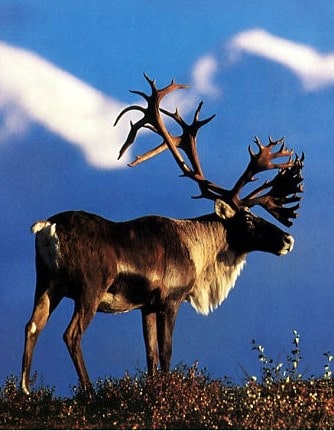
No animal is more strongly associated with the winter holidays than the Reindeer. A member of the Cervidae or Deer family scientifically known as Rangifer tarandus, they are also referred to as Caribou. Occurring throughout the circumpolar region, Reindeer once existed in the billions and formed the largest migrating animal population in the Northern Hemisphere. Humans have hunted them since the Pleistocene Era as a primary source of meat and hides and have used their great antlers for tools, personal ornaments and sacred objects. Even today, people such as the Inuit, Inupiat, Nenets, and Sami depend on reindeer as a primary source of food, clothing, and shelter. The herding of semi-domesticated reindeer is important to numerous Arctic and sub-Arctic peoples, and in some parts of the world, is now managed by helicopter.
The broad, splayed hooves and twin dew claws of reindeer and caribou soften for better traction during warmer months when they roam the boggy tundra to browse on grasses, tender willow shoots and mushrooms. As the days grow shorter, their hooves harden and develop sharp edges to help dig through snow and ice for the lichens that are their winter diet. When running or walking, their hoof and knee tendons make an audible click, helping these herd animals hear each other in blizzard conditions.
Reindeer are the only mammals that can see ultraviolet light, which helps them pick out objects in the dim Arctic winter. Their eyes change color from gold in summer when daylight is abundant to blue in winter, which increases the scatter of reflected light and helps them to see better in the near-constant darkness.
As a species, Reindeer possess a remarkable ability to thrive on a low-nutrition diet of woody plants and lichen. In preparation for sub-freezing temperatures in winter, they grow a dense dual-layered coat that helps them float when our migration routes make swimming necessary. Their guard hairs are hollow, providing insulation and buoyancy, while a dense, fine undercoat offers additional warmth. Reindeer develop the largest antlers of any deer species in relation to their body size. Initially the tender, growing antlers are covered in a rich network of nourishing blood vessels. Later, when the antlers are mature, this fuzzy coating, called velvet, dries and is scraped away on brush and shrubs. Male reindeer use their hardened antlers in battles for females, dropping them at the end of the rutting season. Female reindeer retain their antlers all winter and use them to defend the herd and to dig for lichens beneath the snow. Thus, the animals portrayed drawing Santa’s sleigh across the winter sky are all female!
Our warming climate makes reindeer and caribou increasingly vulnerable to blood-sucking flies and mosquitoes, parasitic maggots that burrow beneath their hides and into their nasal cavities and to the brain worm carried by white-tailed deer now invading their range. A decrease in the snow to which they are adapted, and increased sleet and freezing rain, results in thick layers of hard ice they cannot dig through, causing large numbers to starve. Reindeer and caribou are decreasing world-wide and certain sub-species are now extinct.